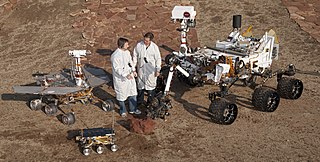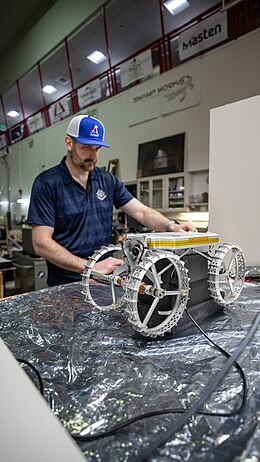
The NASA Institute for Advanced Concepts (NIAC) is a NASA program for development of far reaching, long term advanced concepts by "creating breakthroughs, radically better or entirely new aerospace concepts". The program operated under the name NASA Institute for Advanced Concepts from 1998 until 2007, and was reestablished in 2011 under the name NASA Innovative Advanced Concepts and continues to the present. The NIAC program funds work on revolutionary aeronautics and space concepts that can dramatically impact how NASA develops and conducts its missions.

William L. "Red" Whittaker is an American roboticist and research professor of robotics at Carnegie Mellon University. He led Tartan Racing to its first-place victory in the DARPA Grand Challenge (2007) Urban Challenge and brought Carnegie Mellon University the two million dollar prize. Previously, Whittaker also competed in the DARPA Grand Challenge, placing second and third place simultaneously in the Grand Challenge Races.

A rover is a planetary surface exploration device designed to move over the rough surface of a planet or other planetary mass celestial bodies. Some rovers have been designed as land vehicles to transport members of a human spaceflight crew; others have been partially or fully autonomous robots. Rovers are typically created to land on another planet via a lander-style spacecraft, tasked to collect information about the terrain, and to take crust samples such as dust, soil, rocks, and even liquids. They are essential tools in space exploration.

Astrobotic Technology is an American private company that is developing space robotics technology for lunar and planetary missions. It was founded in 2007 by Carnegie Mellon professor Red Whittaker and his associates with the goal of winning the Google Lunar X Prize. The company is based in Pittsburgh, Pennsylvania. Their first launch occurred on January 8, 2024, carrying the company's Peregrine lunar lander on board the first flight of the Vulcan Centaur Rocket from Florida's Space Force Station LC-41. On June 11, 2020, Astrobotic received a second contract for the Commercial Lunar Payload Services program. NASA will pay Astrobotic US$199.5 million to take the VIPER rover to the Moon, targeting a landing in November 2024.

Hakuto (ハクト) or formerly White Label Space (ホワイトレーベルスペース) was a team formed in early 2008 by a group of experienced space professionals inspired by the challenge of the Google Lunar X PRIZE to develop a robotic Moon exploration mission.

A lunar rover or Moon rover is a space exploration vehicle designed to move across the surface of the Moon. The Apollo Program's Lunar Roving Vehicle was driven on the Moon by members of three American crews, Apollo 15, 16, and 17. Other rovers have been partially or fully autonomous robots, such as the Soviet Union's Lunokhods, Chinese Yutus, and the Indian Pragyan. Four countries have had operating rovers on the Moon: the Soviet Union, the United States, China and India.

The Lunar CATALYST initiative is an attempt by NASA to encourage the development of robotic lunar landers that can be integrated with United States commercial launch capabilities to deliver payloads to the lunar surface.

Lunar Flashlight was a low-cost CubeSat lunar orbiter mission to explore, locate, and estimate size and composition of water ice deposits on the Moon for future exploitation by robots or humans.

Lunar Polar Hydrogen Mapper, or LunaH-Map, was one of the 10 CubeSats launched with Artemis 1 on 16 November 2022. Along with Lunar IceCube and LunIR, LunaH-Map will help investigate the possible presence of water-ice on the Moon. Arizona State University began development of LunaH-Map after being awarded a contract by NASA in early 2015. The development team consists of about 20 professionals and students led by Craig Hardgrove, the principal investigator. The mission is a part of NASA's SIMPLEx program.

Blue Moon is a family of lunar landers and their associated infrastructure, intended to carry humans and cargo to the Moon, currently under development by a consortium led by Blue Origin and including Lockheed Martin, Draper, Boeing, Astrobotic, and Honeybee Robotics. Two versions of Blue Moon are under development: a robotic lander planned to land on the Moon in 2024, and a larger human lander planned to land a crew of four astronauts on the lunar surface for the NASA Artemis V mission in 2029.

Commercial Lunar Payload Services (CLPS) is a NASA program to contract transportation services able to send small robotic landers and rovers to the Moon's south polar region mostly with the goals of scouting for lunar resources, testing in situ resource utilization (ISRU) concepts, and performing lunar science to support the Artemis lunar program. CLPS is intended to buy end-to-end payload services between Earth and the lunar surface using fixed priced contracts. The program was extended to add support for large payloads starting after 2025.
Team AngelicvM is a private company based in Chile that plans to deploy a small rover on the Moon. Their rover, called Unity, is one of various rovers that will be carried by the commercial Peregrine lander manufactured by Astrobotic Technology.

Peregrine Mission One, or the Peregrine Lunar Lander flight 01, is a lunar lander built by Astrobotic Technology, selected as a part of NASA's Commercial Lunar Payload Services (CLPS). Launched on 8 January 2024, at 2:18 am EST, by United Launch Alliance (ULA) aboard the maiden flight of the Vulcan Centaur, it is the first US-built lunar lander launched since the crewed Lunar Module from the Apollo program. The lander carries multiple payloads, with a total payload mass capacity of 90 kg. A fault occurred shortly after separation from the rocket, and the attempt to land on the Moon had to be abandoned.

VIPER is a lunar rover developed by NASA, and currently planned to be delivered to the surface of the Moon in November 2024. The rover will be tasked with prospecting for lunar resources in permanently shadowed areas in the lunar south pole region, especially by mapping the distribution and concentration of water ice. The mission builds on a previous NASA rover concept called Resource Prospector, which was cancelled in 2018.

John Patrick Thornton is an American business executive. He is CEO of Astrobotic Technology Inc. which develops technology for lunar and planetary exploration.
MoonArk is a Moon museum made by Carnegie Mellon University which was launched onboard the Astrobotic Technologies Peregrine lunar lander. It is mounted to the main deck of the lander.

Yaoki is a Moon rover made by Japanese company Dymon to be launched in 2023 by American company Astrobotic Technology on their Peregrine lunar lander. Yaoki was first announced in 2019.















